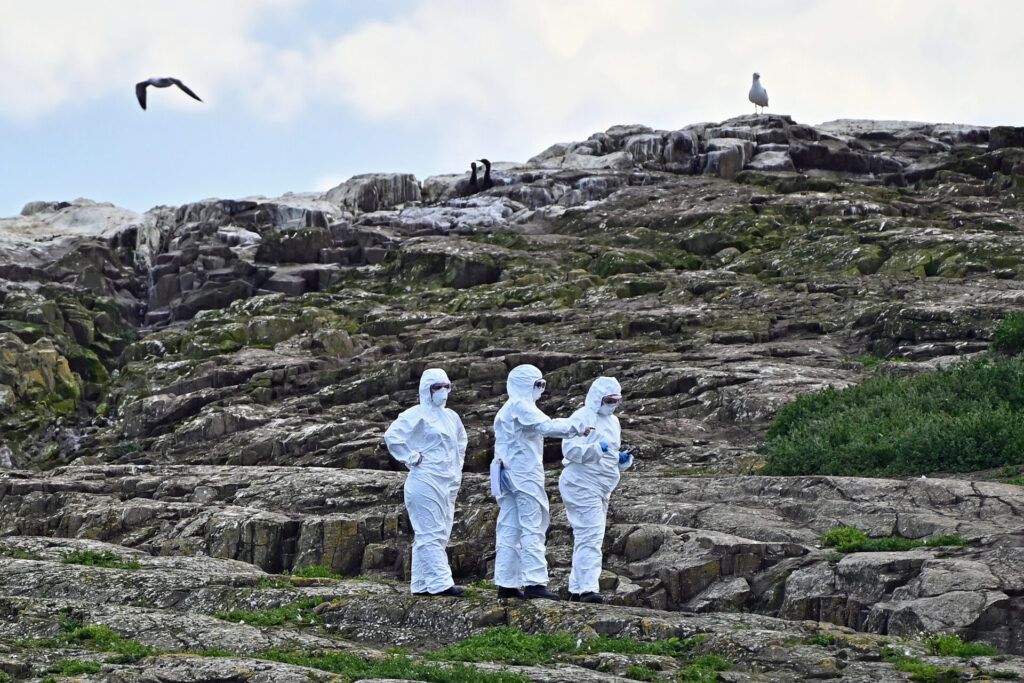Some of the year’s best biosecurity coverage in the Bulletin
By Matt Field | December 28, 2023
 Rangers wear protective equipment last year on Inner Farne Island, an English seabird sanctuary, amid concerns over avian influenza. Credit: Ken Jack/Getty Images.
Rangers wear protective equipment last year on Inner Farne Island, an English seabird sanctuary, amid concerns over avian influenza. Credit: Ken Jack/Getty Images.
Can new artificial intelligence (AI) technologies help would-be bioterrorists plot an attack or design a biological weapon? As avian influenza continues to wreak havoc on bird populations, what are the chances it morphs into the next human pandemic? Is the public health sector staffed up and prepared for another health crisis? These are some of the questions Bulletin writers and experts have addressed over the last year. What follows is some of their best work.
How the ecological crisis of bird flu could become a human pandemic
Thousands of a near-threatened pelican species dying after returning to their colonies. Three thousand Peruvian sea lions lying dead on the shores. The culling of tens of thousands of fur animals. “All these events, evolving in succession, may sound like the beginning of an apocalyptic fiction novel or film. Instead, they’re real-life ecologic emergencies,” infectious disease expert Georgios Pappas writes of highly pathogenic avian influenza. Scientists are watching to see whether H5N1 could evolve from a crisis in nature into a human pandemic.
Catapulting corpses? A famous case of medieval biological warfare probably never happened
There’s an oft-told tale about the history of biological weapons. An army of the Mongol Golden Horde began to fall ill from a mysterious pestilence as they lay siege to an Italian trading fort in modern-day Crimea. Despondent, the Mongols catapulted their dead over the fortress walls, thereby spreading the plague to the traders within. As they fled on ships to ports west, the Italians spread the bubonic plague, initiating the infamous Black Death pandemic that crippled Europe in the late 14th century. The tale, though repeated in encyclopedias, documentaries, and elsewhere, is apocryphal, Jean Pascal Zanders says. I talked with the noted scholar of weapons of mass destruction about his research, which shows that the medieval bioweapons attack most likely did not occur.
Public health position available: Low pay. Promise of burnout and harassment. Master’s preferred.
After several rough COVID years, one might assume that governments and society were better prepared for another pandemic. After all, there have been four major international disease crises in the last two decades; it seems likely that another will strike at some point. But a look at the on-the-ground situation in US public health departments could leave the impression that officials have taken the opposite bet. Funding and resources have dwindled, and the agencies are hemorrhaging the workers who will be critical for “disease surveillance, vaccination campaigns, and assistance in natural disasters like wildfires or hurricanes,” Bulletin editorial fellow Kimberly Ma writes. Pandemic burnout and intimidation are big issues in the field, but there are also structural problems with the way departments hire and nurture workers, Ma argues.
Researchers hacked a lab’s pathogen containment system. Was it a good idea to publish the results?
One group of researchers studied how to hack the negative pressure systems that keep high-risk pathogens inside of research labs. Another made a hybrid SARS-CoV-2 virus that, while less deadly than the original COVID strain, was more deadly to infected mice than the omicron variant. Was it the right decision to publicize these studies involving so-called “dual-use” research—that is, research malicious actors could use to inflict harm? Biosecurity experts George Post and David Gillum write that “to a seemingly greater degree than in other areas, the life sciences are struggling with a lack of clarity on oversight policies for dual-use research, including those regarding publication.”
Protein de-extinction: How Neanderthals and mammoths could help find new antibiotics
For much of human history, injuries or illnesses that are treatable today could spell death for the afflicted. Without antibiotics, infections and debilitating disease could readily take hold. Antibiotics like penicillin made bacterial infections survivable, but, unfortunately, after decades of robust antibiotic development, the stream of new drugs coming onto the market has slowed to a trickle. Scientists have taken to looking in some interesting places for new antibiotic compounds—Komodo dragon blood and bacteria used by some ants, for example. University of Pennsylvania bioengineer Cesar de la Fuente is also researching animals to find potential cures. But unlike Komodo dragons and ants, the species whose biology he’s scouring last walked the Earth tens of thousands of years ago.
Can’t quite develop that dangerous pathogen? AI may soon be able to help
In response to rapidly improving AI technologies, the Biden administration unveiled an executive order that dealt in part with how to reduce the biosecurity risks of these advances in artificial intelligence. Allison Berke, an expert in chemical and biological weapons nonproliferation at the Middlebury Institute, writes that while researchers can use “biodesign” tools to develop biological constructs such as proteins, they can also have the AI “produce designs for a variety of chemical weapons, including some as-yet-unknown candidate compounds predicted to be more toxic than VX, a potent and banned nerve agent.” Another type of AI known as large language models, can provide the steps to synthesize 1918 pandemic influenza and potentially help would-be bioterrorist in other ways. Berke writes that managing the rapidly advancing AI tools will “require assessment and risk mitigation tools with the flexibility to apply to AI models with as-yet-unimagined capabilities.”
Together, we make the world safer.
The Bulletin elevates expert voices above the noise. But as an independent nonprofit organization, our operations depend on the support of readers like you. Help us continue to deliver quality journalism that holds leaders accountable. Your support of our work at any level is important. In return, we promise our coverage will be understandable, influential, vigilant, solution-oriented, and fair-minded. Together we can make a difference.
Keywords: Best of 2023
Topics: Biosecurity














